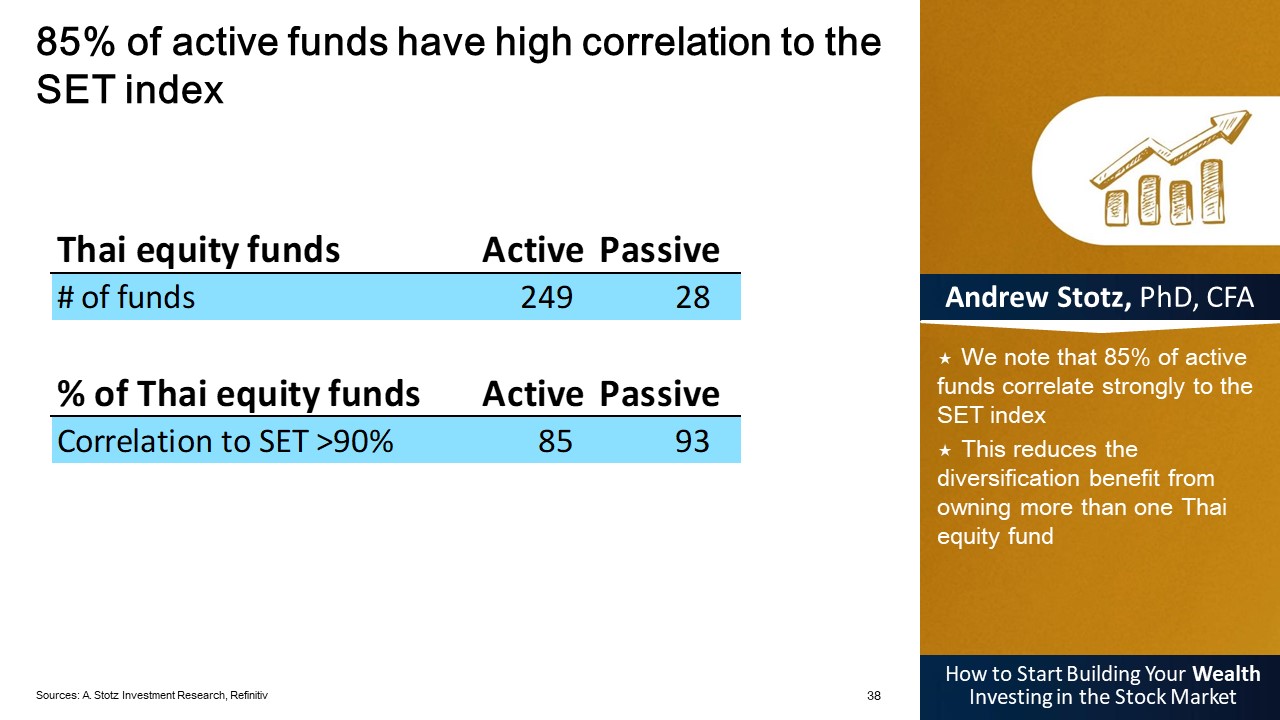Active and Passive Funds in Thailand
What is an active fund?
Most mutual funds in the world are actively managed where a fund manager actively attempts to pick stocks that she thinks will beat the market. Warren Buffett is one of the most well-known active fund managers. The objective of an active fund manager is to beat the market.
The good news is when you invest with an active fund manager because the fund owns many stocks, you reduce unnecessary company-specific risk. But there is one problem, it’s hard to find an active fund manager who can consistently beat the market. Many academic studies looking at the performance of fund managers have concluded that most actively managed funds do not beat the market.
The return that you, the investor, receives is always after the fund manager’s fees. The higher the fees, the harder it is for you to get a high return from an active fund manager. Besides fees, another reason that active fund managers have a hard time outperforming is that the stock market is incredibly complex. Over and over it has been shown that no one can consistently predict the stock market.
What is a passive fund?
A passively managed fund’s objective is to match the stock market index performance, not beat it. These funds do not make bets on individual stocks or sectors, nor do they try to time the market, because they are not trying to outperform it. Most passive funds are also called index funds, meaning that they are trying to just match the stock market index.
The benefit of passively managed funds is that they are low-cost, unlike actively managed funds. Their downside is that they are not “sexy.” They are never going to beat the market because they are the market.
Most people should invest their money in a passively managed index fund. Why?
If financial independence is your goal, it’s probably better to focus on building your wealth through business and then investing that in a passively managed index fund.
How about funds in Thailand?
We look at 277 Thai equity mutual funds of which 90% are active and only 10% are passive.
What is correlation?
Correlation measures how two securities move in relation to each other. The strength of the relationship is expressed in a range between (-100% and 100%).
A perfect positive correlation of 100% means that as the market moves, either up or down, the fund’s performance moves in lockstep, and in the same direction.
A perfect negative correlation of -100% means that as the market moves, either up or down, the fund’s performance moves in lockstep, but in the different direction.
As a rule, >90% or <-90% are considered strong correlation.
85% of active funds and 93% off passive have a strong correlation to the SET index

A strong correlation above 90%, indicates that the fund moves in the same direction as the market. In passive funds we expect the correlation to be strong, above 90%. We note that 85% of active funds correlate strongly to the SET index.
A high correlation reduces the diversification benefit from owning more than one Thai equity fund. It could also mean that the funds have similar holdings as the index. Let’s investigate further.
What is R-squared?
Correlation explains the strength of the relationship between two variables. R-squared measures how much of the variation in the fund performance is explained by the variation in the stock market. R-squared can take a value of 0% to 100%.
Morningstar says, a mutual fund with an R-squared value above 85% has a performance record that is closely related to the index, which means it performs like a passive fund.
78% of active funds and 79% of passive have an R-squared >85%

Among active funds, we expect an R-squared below 70%. But, 78% of active funds have an R-squared above 85%, hence, it appears those funds are closet-indexers. If the active funds with R-squared >85% charge a high fee, you’re better off in lower-cost passive funds.
The number of large and liquid stocks in Thailand is limited (usually about 100) and a portfolio with more than 30 stocks usually perform similar to the benchmark. This means it is harder for large funds to achieve truly active returns. But if they can’t or don’t want to be active, they shouldn’t claim to be active and charge you higher fees for it.
DISCLAIMER: This content is for information purposes only. It is not intended to be investment advice. Readers should not consider statements made by the author(s) as formal recommendations and should consult their financial advisor before making any investment decisions. While the information provided is believed to be accurate, it may include errors or inaccuracies. The author(s) cannot be held liable for any actions taken as a result of reading this article.
